| 1 | Green bush viper |
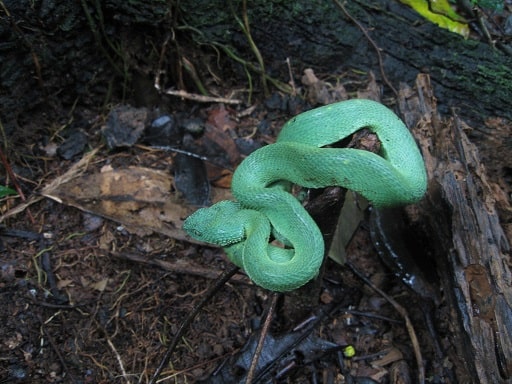
Although snakes drink rainwater, they don’t drink like a human, gulping down huge satisfying mouthfuls. Nor do they lap up water like a dog. Instead, a snake’s mouth is lined with endless small grooves which absorb water like a sponge, which can then be forced down by muscular actions.
Some snakes upgrade to the next generation and don’t even seek out a small pool or stream to drink from. Instead, they just sit there and let rainwater accumulate on their scales, which they lap up. The green bush viper of west Africa (Ivory Coast, Ghana) is one of several species worldwide which do this. It’s a jungle snake, and a lazy one which only moves when it truly has to. For the majority of the time, green bush vipers perch themselves on a branch and stare into space (although they’re likely more alert than they let on). To fulfil this lifestyle, they’re adapted to eat only every few weeks, and have scales optimised for collecting water.
When they need a drink, the green bush viper (Atheris chlorechis) just bends back and drinks droplets off its own scales. The only time they need to move is when pouncing on prey. Green bush vipers stick to forests exclusively, never venturing into towns. Their cousin is the hairy bush viper, one of Earth’s most bizarre snakes.
| 2 | Bothrops moojeni |
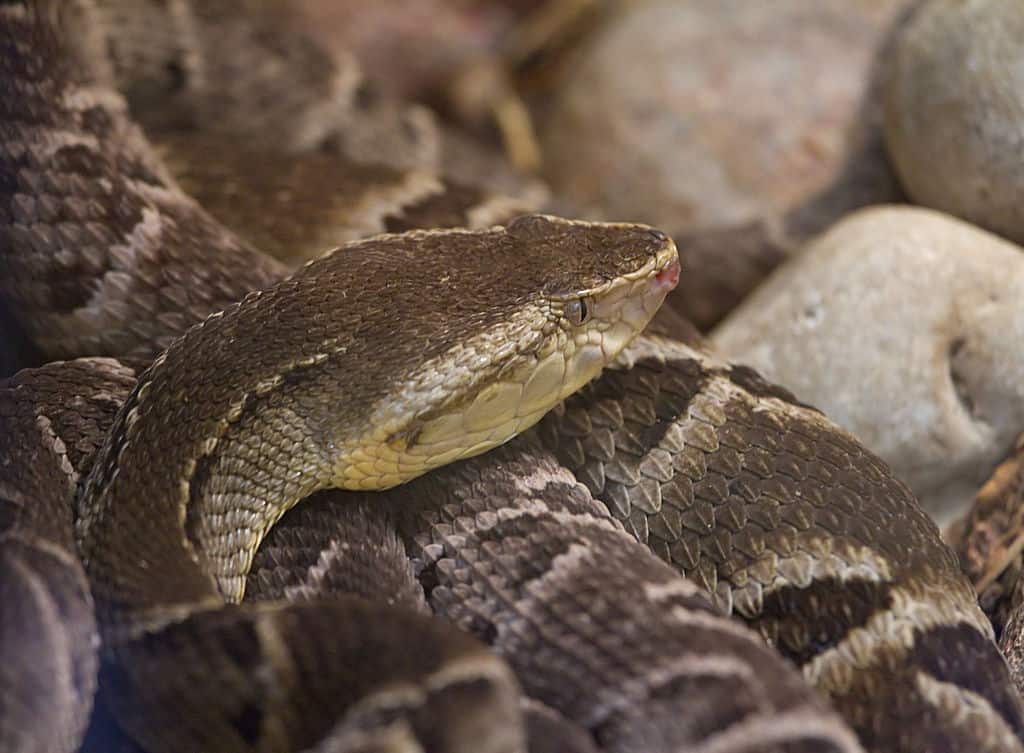
One of southern Brazil’s deadliest snakes. Bothrops moojeni already looks rough and crinkled from a distance, and these furrows are perfect for collecting falling rainwater. This species isn’t completely immobile, living in riverside forests and tree clumps. But moving will spoil the ambush tactics they rely on, and rainwater collection forms a handy back up.
In a 2000 study, scientists analysed this water-collecting skill, and found that Bothrops moojeni coiled up the moment water struck its scales. It kept its coils in very tight loops, to create a steadily building pool. Bothrops moojeni didn’t suddenly work out how to do this, but evolved the skill slowly. One of its ancestors must have had subtly different scales, which reached a tipping point whereby it collected moisture more effectively. This turned out to have survival advantages, and before long, the entire species was now a new, updated version with a next level power.
This species can turn aggressive if cornered by humans, hissing and baring their teeth. With their relatively thick body, collecting rainwater is all the easier. With a cosy riverside habitat, plenty of mammal prey, and a cool rain grabbing trick, Bothrops moojeni isn’t endangered at all. They’re prospering in their southern Brazilian ranges, and show no signs of disappearing.
| 3 | Emerald tree boa |
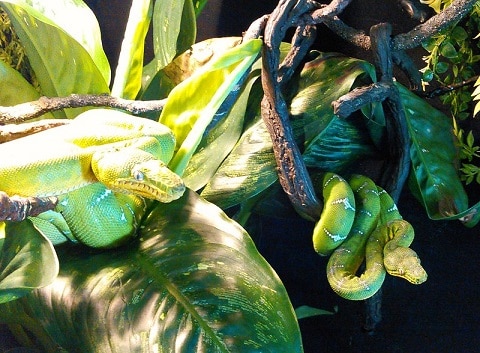
This Amazon species is one of the most immobile snakes in the world. The life of an emerald tree boa looks extremely boring, although we have no idea what’s going on in its mind. They never leave their branch perch, and swing down only to grab tempting mammal prey.
For week after week, the emerald tree boa sits still, staring menacingly. Not even a photographer waving a camera in its face can persuade it to move. Days, even weeks pass, in which the emerald tree boa only raises its head to scope a spiny rat in the distance, before sinking back into its coils, expression unchanging. A tiger ratsnake slithers past. The emerald tree boa doesn’t react. A monkey gets carried off by a hawk before its very eyes. The emerald tree boa still doesn’t react.
With such an overwhelmingly lazy lifestyle, the emerald tree boa needs a way to replenish its moisture, and collecting rainwater on its back is that solution. The emerald tree boa doesn’t even have to try; the rainwater accumulates in its scales, and it swings around and drinks when ready. Emerald tree boas only venture to the ground in times of extreme stress, like if a bird is seconds from taking their life.
| 4 | Peringuey’s adder |
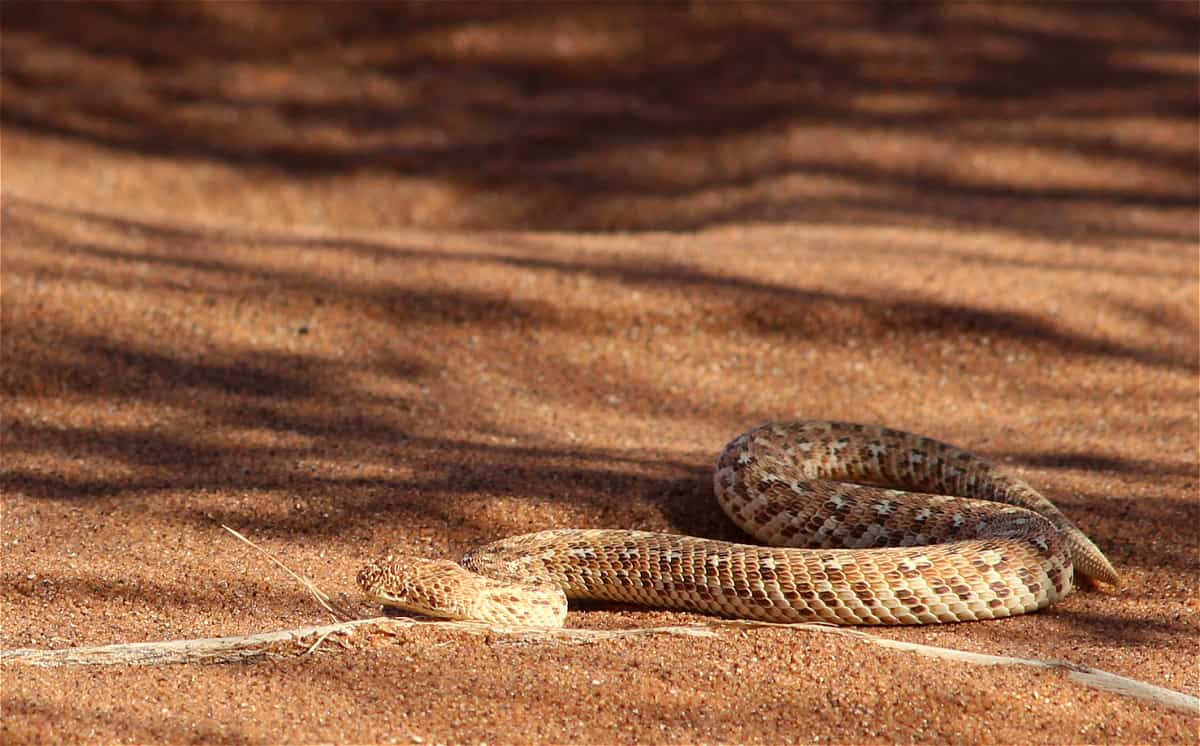
Another desert snake, and another one whose body has adapted for survival, by collecting rainwater on its scales. Peringuey’s adder lives in the sandy deserts of southern Namibia. They’re not as immobile as the emerald tree boa, but can spend hours and hours hidden amidst dry rocks, using their favoured ambush tactics. Peringuey’s adders wait patiently until they hear the scampering of a barking gecko approaching, which gains in intensity until they finally decide to pounce.
The likes of burrowing snakes have such smooth scales that water just runs off them. This is by design, as they don’t want unnecessary soil clinging to them. Peringuey’s adder has scales optimised for collecting small pools of water instead, even though this is hard to make out in pictures. They even flatten their bodies to enhance the collection area. Rain is rare in the Namib desert, but they instinctively maximise every drop they can.
The one obstacle they face is an unusually dry spell, even by desert standards. There they have another back up: condensing mist on their scales, when fog rolls in from the Atlantic ocean to the west.
| 5 | Blunt-headed tree snake |
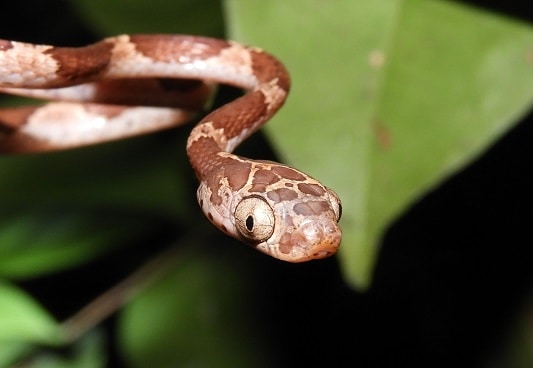
The blunt-headed tree snake ranges from eastern Mexico to northeast Argentina, preferring jungles, but also clearings along forest borders. They’re an actively foraging snake, much more energetic than an emerald tree boa. However, they stay still for long periods when resting or digesting food. If you find one, something you might notice is scales glistening with moisture, which they bend their neck towards and lap up droplets from. Rather than wasting time with a pond, blunt-headed tree snakes just drink off themselves.
This cool ability is found mainly in snakes, mainly because they’re one of the few creatures that can achieve it. A human being is nowhere near flexible enough to collect rainwater and drink it off his back. A gorilla, for all its brute strength, could never bend over backwards and drink off its own fur. Meanwhile, even the bulkiest snakes like blood pythons are flexible enough to rest their heads on their backs. This is nature’s compensation for stealing their arms and legs.
The blunt-headed tree snake might have no arms, and it might be hunted by birds, but it never has to worry about water (unless some dusty desert air blows in). The one obstacle they face is the weather. A dry spell would rob them of all their powers, making them just like any other snake. They too would have to venture to the local pool and lap up water, like snakes they’d previously laughed at.
| 6 | Western diamondback rattlesnake |
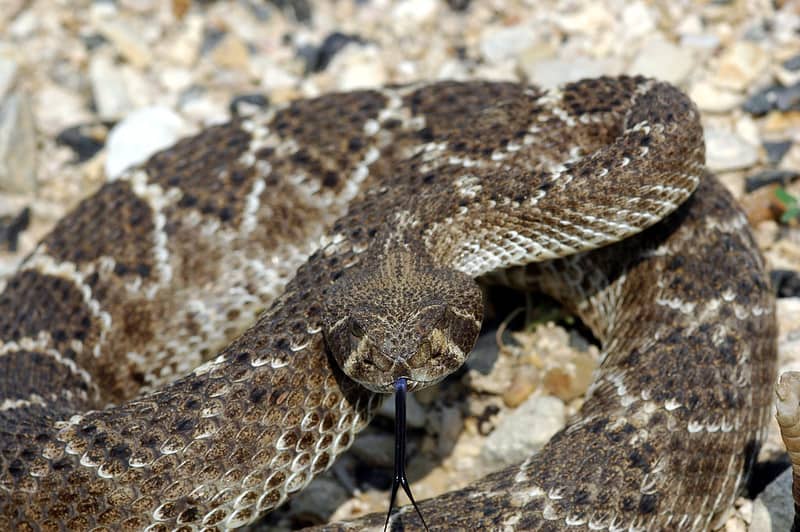
The western diamondback rattlesnake lives in dry areas from southern California to Arkansas, and is the best studied snake species for rain harvesting on scales. This snake sticks to the ground, and mainly feeds on mammals. They cause the highest number of snakebite fatalities in the US per decade, alongside their eastern cousin.
If a caveman wanted to collect rainwater in prehistoric times, he had to find a specially shaped rock, or summon up all his carving skills. The western diamondback, meanwhile, can just relax on its dusty rock slab. It can feel the rainwater pattering against its back, and know with satisfaction that its evening drink is steadily building up.
Western diamondbacks form a deliberate coil shape to encourage water collection. Their scales are specially optimised, as a droplet striking a diamondback will break into several smaller droplets and cling to them. In their neighbours, the desert kingsnake and Sonoran gopher snake, these droplets mostly slide off. Each scale had a detailed nanostructure, with a network of tiny channels, just one tenth of a red blood cell’s width. The depth of these channels was optimised for water collection – adding slightly more or less depth would make them less effective. These features were discovered in a well publicised 2019 study.
| 7 | Coastal taipan |
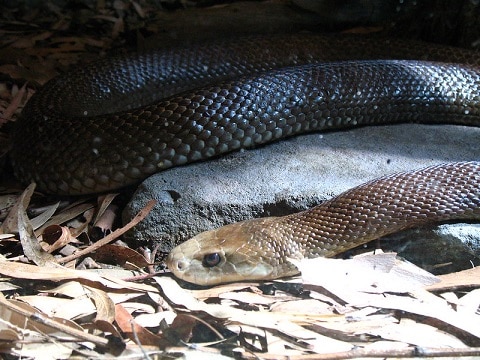
The coastal taipan is the last snake that needs to collect rainwater. It’s fast-moving and energetic, travelling dozens of metres per day, and can lap up water from a pond and move onto its next prey within minutes. Nevertheless, they were observed drinking rainwater off their scales in June 2019, in a female which was basking in front of a dark burrow. The taipan was motionless except slight movements of its head. Six short, sharp rain showers followed, and after each one, the basking snake would lick water off itself. Taipans are energetic, but apparently keep this subtle weapon as a back up in the occasional case that they need to stay still.
This taipan also swallowed rainwater from nearby vegetation. The scientists only realised that it was drinking rainwater off itself after zooming in on the images later, watching the droplets disappear as the taipan’s face moved over them.
While its scales are less optimised than a viper’s jagged ridges, and look smooth from a distance, coastal taipans are still able to collect rainwater droplets. Among Australian snakes, green tree pythons also collect rainwater on their scales, as they’re almost a clone of the emerald tree boa on another continent.
| 8 | Sidewinder |
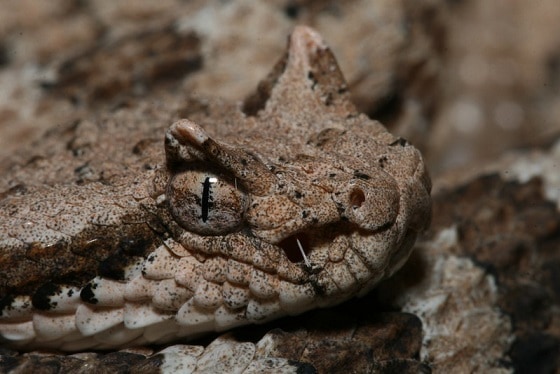
A species of Arizona and Nevada. The sidewinder rattlesnake’s motivations for capturing rainwater are simple – they live in bone dry deserts, and can’t let any moisture go to waste. On the rare occasions that it rains, they have to save every drop they can. That’s where their automatic collection mechanism comes in. Sidewinders have rough, crinkled scales like all rattlesnakes, which are excellent at grabbing falling water droplets, like their west diamondback cousin.
The droplets are prevented from falling to the desert floor wastefully, mingling with sand and becoming inedible. Sidewinders can occupy the most extreme deserts, even Death Valley, and need all their skills to scrape out an existence. Their other adaptions include scales which change colour, being light during summer to reduce sunlight absorption, and dark during winter.
Sidewinders also gain water through their prey, 50% of which is lizards. Their rainwater-collecting skills aren’t used often, but without them, a dehydrated death would be on the horizon. Sidewinder rattlesnakes have few other water sources, with no streams or pools to drink from.
| 9 | Banded water snake |
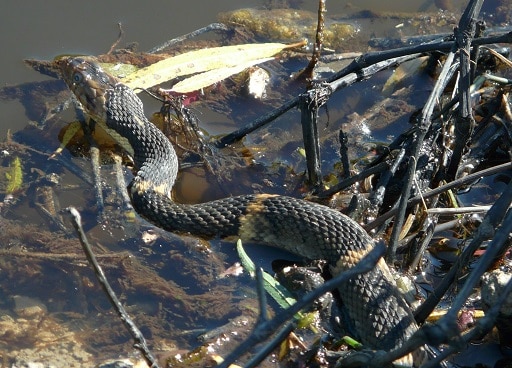
The banded watersnake of Florida is less lazy than others, and doesn’t necessarily need rain-collecting skills, yet it has them anyway. This serpent has made the wise decision to acquire as many snake powers as possible.
Banded water snakes measure 65-105cm, and stick to water bodies like marshes and lakes, where they particularly prefer vegetation along the edges. They cunningly exploit many of the Earth’s natural resources: logs for shelter, branches to rest on, streams to dive into, and rainwater stored on their back for moisture. This snake knows that rain is its friend, not something to fear. With no effort required, thousands of tiny droplets combine and form a reserve stash of moisture.
The banded watersnake lives in temperate to humid zones and isn’t under much pressure. You can find Nerodia fasciata from Florida to Louisiana to southern Illinois. They have no venom, though a vicious pair of teeth, and they rely on grabbing their prey, which is mainly fish and frogs. Banded watersnakes overlap with brown watersnakes, but are distinguishable by their namesake bands.
| 10 | Mamushi |
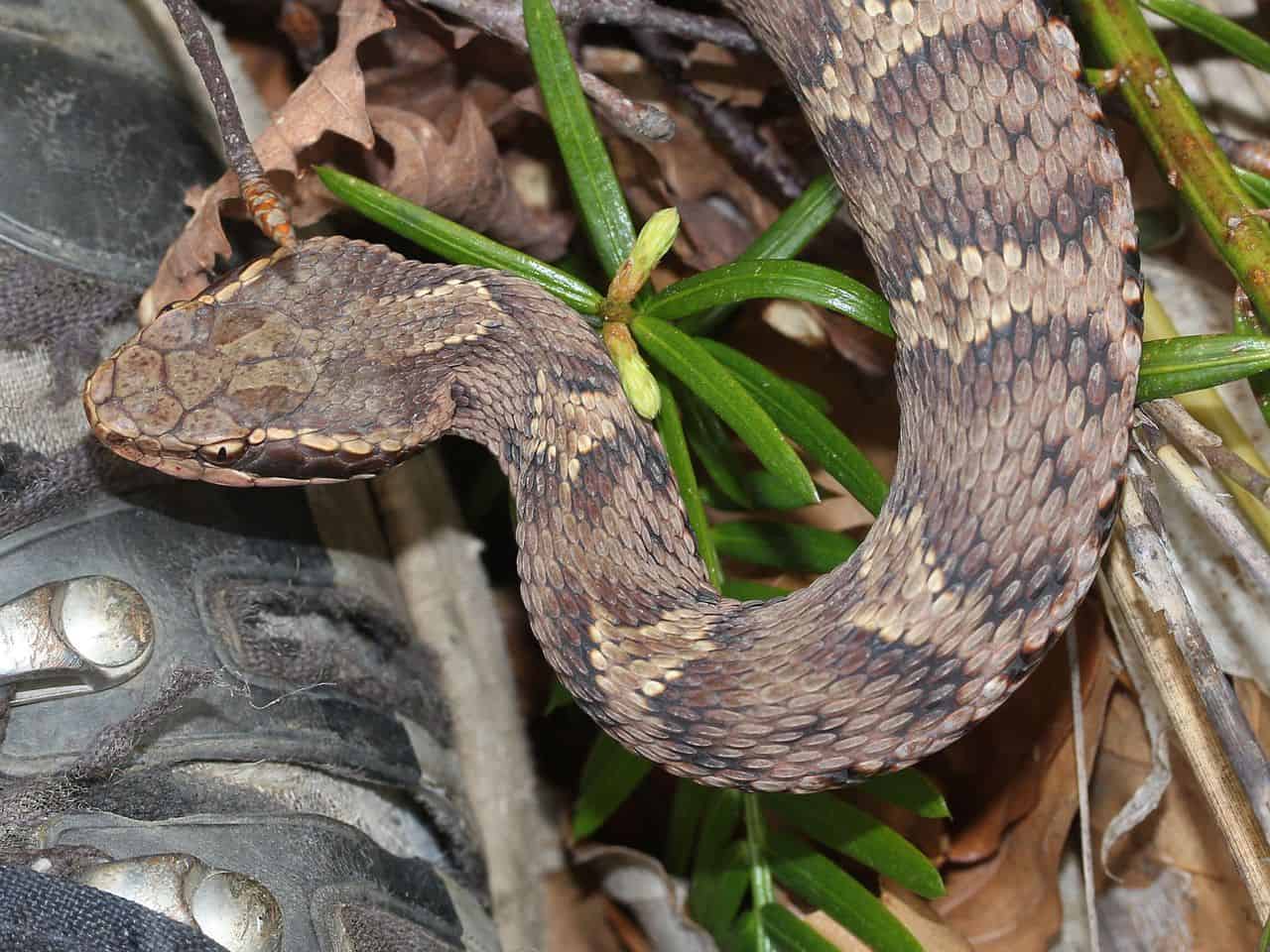
This 50-80cm snake lives in leafy woodlands of Japan, typically close to human inhabited areas like villages. Mamushis belong to the Gloydius family, which are all venomous and number 26 across eastern Asia.
Rather than smooth and sleek, the mamushi is gnarly and jagged like an old tree trunk. This is a strategic advantage, as it allows them to collect rainwater in their scales, which they eventually drink. Collecting rainwater isn’t just a cool gimmick, but vital for their hunting strategy. Patience is the key for an ambushing snake, and interrupting it for a trip to the village river would be disastrous. The entire local colony of rats would realise that there’s a hungry pitviper around, and be put on their guard.
The mamushi is fairly thick, yet still flexible enough to bend back and drink from their own personal rainwater pool with ease. This tendency was first observed in Hokkaido, Japan in 2002, in 3 sperate mamushis after brief rain showers swept in. What’s less known is how they react when animals try to steal their rainwater stash – extreme rage is most likely. In reality, it probably never happens, as rats have loads of places to drink from. Mamushis have numerous heat-seeking labial pits in their heads, granting them night vision.
